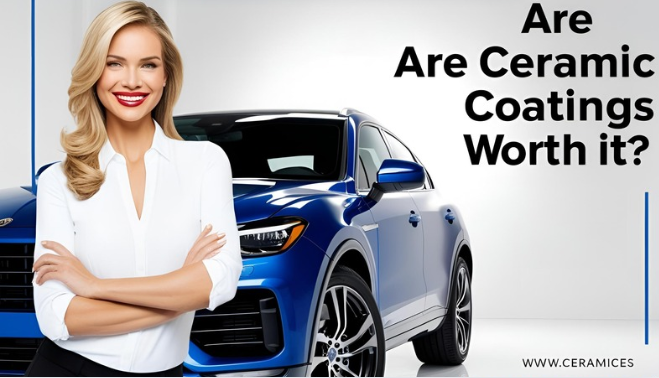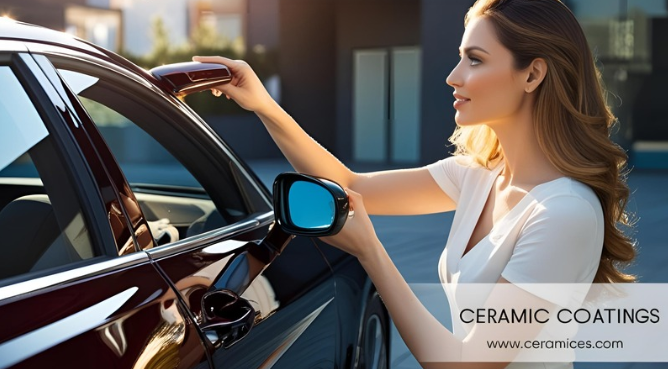Ceramic coatings have become a buzzword in the automotive and home improvement industries, promising unparalleled protection and shine for various surfaces. But are ceramic coatings worth the investment? This article will explore the benefits, drawbacks, and applications of ceramic coatings to help you decide if they are the right choice for your needs. Whether you’re a car enthusiast looking to protect your vehicle’s paint or a homeowner seeking to enhance your countertops, this guide will provide you with all the information you need about ceramic coatings.
What Are Ceramic Coatings?
Ceramic coatings are liquid polymers that, when applied to a surface, chemically bond with it to create a durable, protective layer. These coatings are made from silicon dioxide (SiO2) or titanium dioxide (TiO2) and are known for their hydrophobic properties, meaning they repel water and contaminants. Ceramic coatings are commonly used on cars, boats, and household surfaces like countertops and tiles.
Types of Ceramic Coatings

There are several types of ceramic coatings, each designed for specific applications:
1. Automotive Ceramic Coatings
These coatings are applied to a vehicle’s exterior to protect the paint, enhance shine, and make cleaning easier.
2. Marine Ceramic Coatings
Used on boats and other watercraft, these coatings protect against saltwater, UV rays, and other environmental factors.
3. Industrial Ceramic Coatings
These coatings are used in industrial settings to protect machinery, equipment, and structures from corrosion, heat, and wear.
4. Household Ceramic Coatings
Applied to surfaces like countertops, tiles, and glass, these coatings provide protection against stains, scratches, and heat.
Benefits of Ceramic Coatings
Ceramic coatings offer numerous advantages that make them a popular choice for various applications. Here are the key benefits:
1. Enhanced Protection
Ceramic coatings provide a strong protective layer that shields surfaces from UV rays, oxidation, and environmental contaminants like bird droppings, tree sap, and road salt.
2. Hydrophobic Properties
The hydrophobic nature of ceramic coatings causes water to bead up and roll off the surface, making it easier to clean and reducing the risk of water spots.
3. Long-Lasting Shine
Ceramic coatings enhance the gloss and depth of the surface, giving it a showroom-quality finish that lasts for years.
4. Durability
Unlike traditional waxes and sealants, ceramic coatings are highly durable and can last for several years with proper maintenance.
5. Chemical Resistance
Ceramic coatings are resistant to harsh chemicals, making them ideal for protecting surfaces from acidic contaminants and cleaning agents.
6. Scratch Resistance
While not completely scratch-proof, ceramic coatings provide an additional layer of protection against minor scratches and swirl marks.
Drawbacks of Ceramic Coatings
While ceramic coatings offer numerous advantages, they also have some drawbacks:
1. Higher Cost
Ceramic coatings are generally more expensive than traditional waxes and sealants. However, their durability and performance often justify the higher price.
2. Professional Application
While some ceramic coatings are designed for DIY application, professional-grade coatings often require specialized equipment and expertise, adding to the overall cost.
3. Preparation Required
Proper surface preparation is crucial for the effective application of ceramic coatings. This often involves thorough cleaning, decontamination, and sometimes even paint correction.
4. Maintenance
While ceramic coatings reduce the need for frequent cleaning, they still require regular maintenance to preserve their effectiveness and appearance.
5. Not Completely Scratch-Proof
Ceramic coatings provide additional protection against minor scratches, but they are not completely scratch-proof and can still be damaged by sharp objects or heavy impacts.
Applications of Ceramic Coatings

Ceramic coatings are used in a wide range of applications, each benefiting from their protective and aesthetic properties:
1. Automotive
Ceramic coatings are commonly used on cars to protect the paint, enhance shine, and make cleaning easier. They are applied to the exterior surfaces, including the paint, wheels, and glass.
2. Marine
Boats and other watercraft benefit from ceramic coatings that protect against saltwater, UV rays, and other environmental factors. These coatings are applied to the hull, deck, and other exterior surfaces.
3. Industrial
In industrial settings, ceramic coatings protect machinery, equipment, and structures from corrosion, heat, and wear. They are used on surfaces like metal, concrete, and ceramics.
4. Household
Ceramic coatings are applied to household surfaces like countertops, tiles, and glass to provide protection against stains, scratches, and heat. They are also used on appliances and fixtures to enhance their durability and appearance.
How to Apply Ceramic Coatings
Proper application is crucial for achieving the best results with a ceramic coating. Here’s a step-by-step guide:
1. Prepare the Surface
Thoroughly clean and decontaminate the surface to remove dirt, grease, and contaminants. Use a clay bar to remove embedded particles.
2. Polish the Surface
Polish the surface to remove any scratches or swirl marks and ensure a smooth, even finish.
3. Apply the Coating
Apply the ceramic coating in small sections using an applicator pad. Follow the manufacturer’s instructions for the recommended number of layers.
4. Allow to Cure
Let the coating cure according to the manufacturer’s instructions. Avoid exposing the surface to water or contaminants during the curing process.
5. Maintain the Coating
Regularly wash and maintain the coated surface to preserve its appearance and durability. Use pH-neutral car wash soap and avoid harsh chemicals.
FAQs: Are Ceramic Coatings Worth It?
1. Are ceramic coatings worth the cost?
Yes, ceramic coatings provide long-lasting protection and enhance the appearance of surfaces, making them a worthwhile investment.
2. How long do ceramic coatings last?
Consumer-grade coatings typically last 1-2 years, while professional-grade coatings can last up to 5 years or more with proper maintenance.
3. Can I apply ceramic coating myself?
Yes, consumer-grade coatings are designed for DIY application. However, professional-grade coatings should be applied by trained detailers.
4. Do ceramic coatings prevent scratches?
While not completely scratch-proof, ceramic coatings provide an additional layer of protection against minor scratches and swirl marks.
5. What surfaces can be coated with ceramic coating?
Ceramic coatings can be applied to cars, boats, motorcycles, glass, metal, and even household items like countertops and tiles.
6. How do I maintain a ceramic-coated surface?
Regularly wash the surface with pH-neutral soap, avoid harsh chemicals, and reapply a maintenance spray to preserve the coating.
7. Can ceramic coating be removed?
Yes, ceramic coatings can be removed through polishing or using specialized removal products. However, the process can be time-consuming.
8. What is the difference between SiO2 and TiO2 coatings?
SiO2 coatings are known for their hydrophobic properties, while TiO2 coatings offer enhanced UV protection and durability.
9. Are there any downsides to ceramic coating?
The main downsides are the cost and the need for proper surface preparation. However, the benefits often outweigh these drawbacks.
10. How do I choose the best ceramic coating?
Consider factors such as the type of surface, durability, ease of application, and maintenance requirements. Read reviews and recommendations to find a product with a proven track record.
Conclusion: Are Ceramic Coatings Worth It?
Ceramic coatings offer numerous benefits, including enhanced protection, a long-lasting shine, and easier maintenance. While they come with a higher upfront cost and require proper preparation and application, their durability and performance often justify the investment. Whether you’re looking to protect your car’s paint, enhance your boat’s exterior, or safeguard your household surfaces, ceramic coatings provide a reliable and effective solution.
So, the next time you ask, “Are ceramic coatings worth it?” consider the specific needs of your surfaces and the long-term benefits of enhanced protection and aesthetics. By choosing the right ceramic coating and following proper application and maintenance techniques, you can enjoy the peace of mind that comes with knowing your surfaces are well-protected and looking their best. Whether you’re a car enthusiast, a boat owner, or a homeowner, ceramic coatings are a valuable investment that can enhance the beauty and durability of your prized possessions.
Read more
1 Can you Apply Ceramic Coating Over Ceramic Coating
2 What is the Best Ceramic Coating? Choosing the Right Ceramic Coating